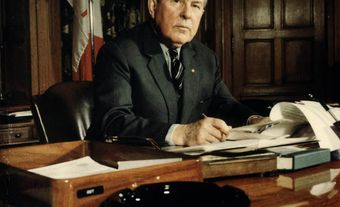Egypt Seizes Canal

The Suez Canal directly links the Mediterranean Sea to the Red Sea. It was built by Egyptian workers under the French and British-owned Suez Canal Company, and opened in 1869. The company was seized and nationalized by Egyptian President Gamal Abdel Nasser on 26 July 1956. The move worried Western governments, as the canal was a vital route for oil travelling to Britain. If Egypt blocked the flow of oil, Nasser could badly damage the British economy.
The Egyptian seizure came during the Cold War, further ratcheting up the tensions. Egypt’s stated reason for the nationalization of the canal was to use the shipping tolls to finance construction of the Aswan Dam — which promised to control flooding on the Nile, and provide hydroelectricity as well as other means of industrializing the country. Nasser continued to operate the canal as usual, but Britain, France and their regional ally Israel began plotting a military response. Nasser, meanwhile, obtained military arms from the Soviet Union.
Bombing the Canal

When diplomacy failed to produce a solution, France, Britain and Israel secretly plotted to attack, without informing the US, Canada and other NATO allies. Israeli forces advanced on 29 October to within 42 kilometers of the canal. Britain and France ordered both Israel and Egypt to withdraw from the Canal Zone (a move pre-planned with Israel). Nasser did not retreat. On 31 October, Britain and France began bombing the Canal Zone.
The US, not wanting a war, had urged Britain to seek peace. British aggression in Egypt caused the biggest rift between these important allies in the 20th century.
Canada Becomes Peacemaker

Publicly, the Canadian government’s role was that of conciliator. Privately, however, Ottawa strongly objected to the military action out of concern that it was dividing the Commonwealth, damaging relations with the US, and risking a wider war.
Pearson was Canada’s secretary of state for external affairs (foreign minister) and headed Canada’s delegation to the UN. He had played an important role in the creation of the state of Israel in 1947. He spent the summer and fall of 1956 working toward a diplomatic solution to the Suez Crisis. When that failed, and the bombing began, Pearson changed tactics.
Working with colleagues at the UN, he developed the idea for the UN’s first, large-scale peacekeeping force. At that time, UN military observers were already being used to monitor cease-fire agreements in Kashmir and Palestine, but a more robust and armoured peacekeeping force had not been tried before.
Addressing the UN General Assembly in New York, in the midst of the Suez Crisis, Pearson made his case for a “peace and police force,” saying: “Peace is far more than ceasing to fire.”
On 4 November, 57 UN states voted in favour of the idea and 19 abstained; no country voted against the peacekeeping mission. The following day, however, British and French paratroops ignored the vote and landed in the Canal Zone.
The US continued to pressure British Prime Minister Sir Anthony Eden to find a peaceful resolution. A cease-fire was arranged, beginning on 6 November, and UN peacekeepers later entered the canal area. Pearson’s solution allowed Britain, France and Israel to withdraw their forces without giving the appearance of having been defeated. A United Nations Emergency Force (UNEF) under the command of Canadian General E.L.M. Burns, and including a Canadian supply and logistics contingent, was in place by late November.

Pearson Wins the Nobel Peace Prize
Pearson won the 1957 Nobel Peace Prize for his initiative in Egypt. In his acceptance speech, he highlighted Canada's important role in the breakthrough.
“I realise also that I share this honour with many friends and colleagues who have worked with me for the promotion of peace and good understanding between peoples. I am grateful for the opportunities I have been given to participate in that work as a representative of my country, Canada, whose people have, I think, shown their devotion to peace.”
Some in Canada and Britain objected to Ottawa's perceived lack of support for Britain. In the 1957 Canadian election, Pearson’s Liberals, under the leadership of Prime Minister Louis St–Laurent, faced accusations that they had betrayed Britain — still regarded by many Canadians as the Mother Country. Pearson defended his position as the best way to stop the fighting before it spread. The hostile view of some Canadians towards their country's role in the Suez Crisis is thought to have played a part in the Liberal government's defeat in the national election.
Pearson, however, would go on to become prime minister six years later in 1963. And his role in creating the UN’s first modern peacekeeping force pointed the way to the future; UN-sponsored peacekeeping missions would become the proud centrepiece of Canada's military and diplomatic activities around the world for decades to come.

 Share on Facebook
Share on Facebook Share on X
Share on X Share by Email
Share by Email Share on Google Classroom
Share on Google Classroom



